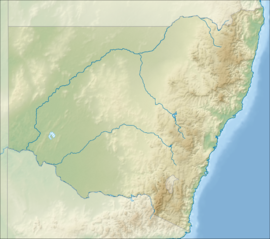Our website is made possible by displaying online advertisements to our visitors.
Please consider supporting us by disabling your ad blocker.
Wollongong
| Wollongong New South Wales | |||||||||||||||
|---|---|---|---|---|---|---|---|---|---|---|---|---|---|---|---|
| Coordinates | 34°25′38″S 150°53′38″E / 34.427243°S 150.893915°E | ||||||||||||||
| Population | 280,153 (UCL 2021)[1][2] | ||||||||||||||
| Postcode(s) | 2500 | ||||||||||||||
| Elevation | 5 m (16 ft) | ||||||||||||||
| Area | 572.2 km2 (220.9 sq mi) | ||||||||||||||
| Time zone | AEST (UTC+10) | ||||||||||||||
| • Summer (DST) | AEDT (UTC+11) | ||||||||||||||
| Location | |||||||||||||||
| LGA(s) | |||||||||||||||
| Region | Illawarra | ||||||||||||||
| State electorate(s) | |||||||||||||||
| Federal division(s) | Cunningham | ||||||||||||||
| |||||||||||||||
| |||||||||||||||
Wollongong (/ˈwʊlənɡɒŋ/ WUUL-ən-gong; Dharawal: Woolyungah) is a city located in the Illawarra region of New South Wales, Australia. The name is believed to originate from the Dharawal language, meaning either 'five islands/clouds', 'ground near water' or 'sound of the sea'.[3] Wollongong lies on the narrow coastal strip between the Illawarra Escarpment and the Pacific Ocean, 85 kilometres (53 miles) south of Sydney.[4] Wollongong had an estimated urban population of 302,739 at June 2018, making it the third-largest city in New South Wales after Sydney and Newcastle and the tenth-largest city in Australia by population.[5] The city's current Lord Mayor is Tania Brown who was elected in 2024.[6]
The Wollongong area extends from Helensburgh in the north to Windang and Yallah in the south. Geologically, the city is located in the south-eastern part of the Sydney basin, which extends from Newcastle to Nowra.[7]
Wollongong is noted for its heavy industry, its port activity and the quality of its physical setting, occupying a narrow coastal plain between an almost continuous chain of surf beaches and the cliffline of the rainforest-covered Illawarra escarpment. It has two cathedrals, churches of many denominations and the Nan Tien Temple. Wollongong has a long history of coal mining and industry. The city attracts many tourists each year[8] and is a regional centre for the South Coast fishing industry. The University of Wollongong has around 38,000 students.[9]
- ^ Australian Bureau of Statistics (28 June 2022). "Wollongong (urban centre and locality)". Australian Census 2021 QuickStats. Retrieved 10 December 2022.
- ^ Australian Bureau of Statistics (28 June 2022). "Wollongong (urban centre and locality)". Australian Census 2021.
- ^ Croucher, John S. (2020). A Concise History of New South Wales. Woodslane Press. ISBN 978-1-92-586839-5.
The name 'Wollongong' is thought to come from the Dharawal language, although its meaning is debated. One interpretation is 'five islands/clouds', another is that it means 'ground near water', yet another that it means 'sound of the sea'.
- ^ Distance from Hyde Park in Sydney city center to Wollongong railway station in Wollongong city center – Google Maps
- ^ "Regional Population Growth, Australia, 2016–17". ABS. 24 April 2018. Archived from the original on 26 April 2018. Retrieved 6 October 2018.
- ^ "Local Government Elections 2024: Wollongong - Mayoral Results". NSW Electoral Commission. Retrieved 25 October 2024.
- ^ "Basin gif". Dept of Primary Industries. Archived from the original on 17 September 2011. Retrieved 12 July 2011.
- ^ "Illawarra Facts & Figures". Tourism NSW. Archived from the original on 25 May 2009. Retrieved 2 January 2009.
- ^ "Key Statistics". University of Wollongong. Archived from the original on 17 December 2008. Retrieved 2 January 2009.
Previous Page Next Page









